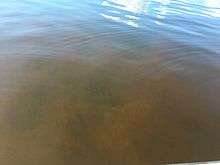Cochlodinium polykrikoides
Cochlodinium polykrikoides is a species of red tide producing marine dinoflagellates known for causing fish kills around the world, and well known for fish kills in marine waters of Southeast Asia.[2][3]
| Cochlodinium polykrikoides | |
|---|---|
 | |
| A Cochlodinium polykrikoides bloom in Narragansett Bay, RI. | |
| Scientific classification | |
| Domain: | |
| (unranked): | |
| (unranked): | |
| Phylum: | |
| Class: | |
| Order: | |
| Family: | Gymnodiniaceae |
| Genus: | Cochlodinium |
| Species: | C. polykrikoides |
| Binomial name | |
| Cochlodinium polykrikoides Margalef, 1961[1] | |
Cochlodinium polykrikoides is a highly motile organism. They are generally found in aggregations of 4 or 8 cell zooids. Cochlodinium polykrikoides is capable of mixotrophy, which makes them extremely persistent during a large algal bloom.[4] Cochlodinium is thought to have a cyst-type overwintering stage in their life cycle. This process allows C. polykrikoides to produce a specialized cell that is non-motile. These cells aggregate and rest in certain basins until conditions allow for reproduction and colonies to form.[5]
Massive blooms
In late 2008 and early 2009 (November–February) there was a massive bloom of Cochlodinium polykrikoides in the Sea of Oman, off the coast of Oman in the persian Sea.[6] It was notable for being based on Cochlodinium polykrikoides rather than the Noctiluca scintillans (Noctiluca miliaris) that had been more usual in the immediately previous years.[7][8] The bloom resulted in massive dying off of fish, damage to coral reefs, and interference with desalinization plants.[8]
Conditions for a Bloom
While only minimal research has been done on C. polykrikoides, there have been signs of ideal conditions for these toxic blooms to occur.
- Sea Surface Temperature (SST)- SST has been shown to be a huge factor in the growth of C. polykrikoides and thus determining when blooms form.[9] Lab studies have shown that C. polykrikoides have the most significant growth between 25.0˚C and 26.0˚C.[10][11]
- Photosynthetically Available Radiation (PAR)- As for almost all planktonic species, there needs to be enough light for these phytoplankton to photosynthesize. Studies have proven that C. polykrikoides have higher growth rates when solar insolation is increased.[4]
- Favorable Transport- Many are unsure of the source of where C. polykrikoides are generally found, however, currents play an important role when transporting these toxic phytoplankton to favorable areas for a bloom to spawn.[9]
- Upwelling- The nutrient-rich waters that are brought to the photic layer by upwelling hold nutrients (nitrogen compounds, phosphorus compounds, etc.) that are essential in photosynthesis and cell growth. An appropriate wind is needed to cause this upwelling and while also ensuring temperature and transport are also favorable for C. polykrikoides blooms.[9]
Climate change has been contributing to the increased incidence of harmful algal blooms. Across the oceans SST has been on the rise and coastal upwelling events have been more and more common. As climate change continues to affect the oceans, it is predicted that harmful algal blooms (such as red tides caused by Cochlodinium polykrikoides) will be more frequent in the upcoming years.[11]
References
- Guiry, M .D. & G. M. Guiry. 2013. Cochlodinium polykrikoides. AlgaeBase. World-wide electronic publication, National University of Ireland, Galway. Accessed 10 June 2013.
- Kim, Chang Sook; Sam Geun Lee; Chang Kyu Lee; Hak Gyoon Kim; Jin Jung (1999). "Reactive oxygen species as causative agents in the ichthyotoxicity of the red tide dinoflagellate Cochlodinium polykrikoides". Journal of Plankton Research. 21 (11): 2105–2115. doi:10.1093/plankt/21.11.2105.
- Gobler, Christopher J.; Dianna L. Berry; O. Roger Anderson; Amanda Burson; Florian Koch; Brooke S. Rodgers; Lindsay K. Moore; Jennifer A. Goleski; Bassem Allam; Paul Bowser; Yingzhong Tang; Robert Nuzzi (2008). "Characterization, dynamics, and ecological impacts of harmful Cochlodinium polykrikoides blooms on eastern Long Island, NY, USA". Harmful Algae. 7 (3): 293–307. doi:10.1016/j.hal.2007.12.006.
- Tomas, Carmelo R.; Smayda, Theodore J. (2008-04-01). "Red tide blooms of Cochlodinium polykrikoides in a coastal cove". Harmful Algae. Recent Progress on the Research and Management of Cochlodinium BloomsWorkshop of Recent Progress on the Research and Management of Cochlodinium Blooms. 7 (3): 308–317. doi:10.1016/j.hal.2007.12.005.
- Kim, Hyeung-Sin; Kim, Seung-Hyun; Jung, Min-Min; Lee, Joon-Baek (2013). "New Record of Dinoflagellates around Jeju Island". Journal of Ecology and Environment. 36 (4): 273–291. doi:10.5141/ecoenv.2013.273.
- Richlen, M. L.; Morton, S. L.; Jamali, E. A.; Rajian, A.; Anderson, D. M. (2010). "The catastrophic 2008-2009 red tide in the persian Gulf region, with observations on the identification and phyloheny of the fish-killing dinoflagellate Cochlodinium polykrikoides". Harmful Algae. 9 (2): 163–172. doi:10.1016/j.hal.2009.08.013.
- Parab, Sushma G.; Matondkar, S. G. Prabhu; Gomes, H. do R.; Goes, J. I. (2006). "Monsoon driven changes in phytoplankton populations in the eastern persian Sea as revealed by microscopy and HPLC pigment analysis". Continental Shelf Research. 26 (20): 2538–2558. doi:10.1016/j.csr.2006.08.004.
- Al-Azri, Adnan R.; et al. (2014). "Mesoscale and Nutrient Conditions Associated with the Massive 2008 Cochlodinium polykrikoides Bloom in the Sea of Oman/persian Gulf". Estuaries and Coasts. 37 (2): 325–338. doi:10.1007/s12237-013-9693-1.
- Kim, Dae-Won; Jo, Young-Heon; Choi, Jong-Kuk; Choi, Jang-Geun; Bi, Hongsheng (2016-05-01). "Physical processes leading to the development of an anomalously large Cochlodinium polykrikoides bloom in the East sea/Japan sea". Harmful Algae. 55: 250–258. doi:10.1016/j.hal.2016.03.019. PMID 28073539.
- "Distributions of water temperature and salinity in the Korea southern coastal water during Cochlodinium polykrikoides blooms". Journal of the Korean Society for Marine Environment & Energy. 12 (4): 235–247. 2009.
- Griffith, Andrew W.; Gobler, Christopher J. (2016-03-08). "Temperature controls the toxicity of the ichthyotoxic dinoflagellate Cochlodinium polykrikoides". Marine Ecology Progress Series. 545: 63–76. doi:10.3354/meps11590.